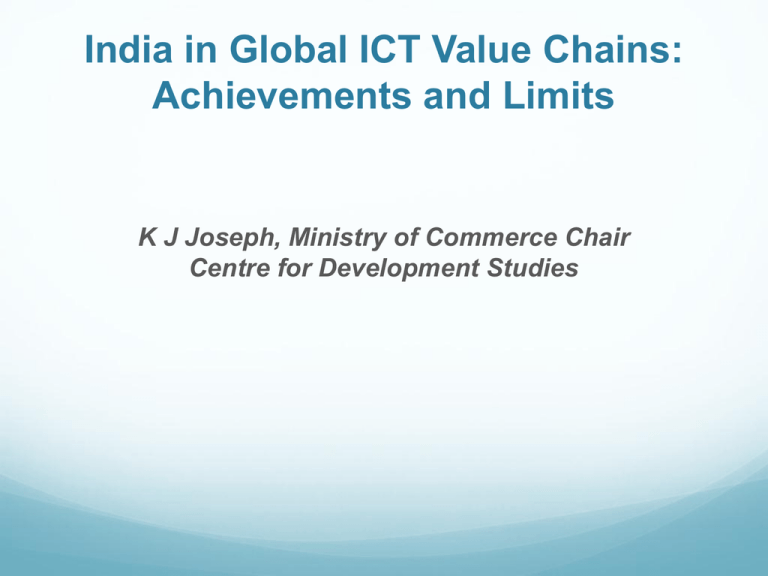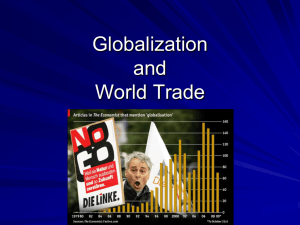India in Global ICT Value Chains: Achievements and Limits
advertisement

India in Global ICT Value Chains: Achievements and Limits K J Joseph, Ministry of Commerce Chair Centre for Development Studies The Context Innovations in ICT is perhaps the greatest contribution in the in the sphere of technology by the previous century to the present century and beyond UNCTAD, among others, has highlighted how ICTs could foster more inclusive development along with contributing to productivity and international competitiveness It has also been argued that being a general purpose technology, harnessing ICT for development presupposes the development of capabilities in both hardware and software AND in the sphere of production and use The Issues India’s experience in integrating with ICT Global Value Chain has often been considered as inspirational for other developing countries But the key issue is with respect her performance in software vis-à-vis hardware (electronics) and in production vis-a-vis use. It is instructive also to compare India’s performance with that of China The issue assumes importance because a lop sided approach, it has been argued, has the potential danger of perpetuating technological dependence and accentuating polarization among counties Software sector opportunities Low capital barriers to entry Generator of employment – not least for the skilled youth India: IT-BPO employed some 2.6 Million in 2011 Source of innovation India: 400+ new software product companies since 2001 Source of export revenue India: Software and BPO services exports of $58 billion in 2010/11 Key to sustain productive ICT use in society Hardware sector opportunities Electronics production is a major source of employment and income in developed countries For example, in 2010, ICT industries employed 5.8 per cent of workers in OECD economies recording a 13 per cent increase since 1995. Production of IT goods has been a major source of output, exports and job creation even in countries like South Korea, Singapore, Thailand, Malaysia and others. Industry segments like microprocessors are almost closed because standards are set by the leading US based firms like Intel. Moreover most segments of IT industry are highly capital intensive and scale intensive and require specialized skills that only a few countries can hope to achieve Yet, being a multi-product industry with vary levels of capital intensity and technology, the doors are not firmly closed for developing countries. India is Global software value chain Trend in Software Production and Exports: Unprecedented- but global crisis had its impact Year Software production ($ Mill) Annual growth rate (%) 1990-91 209 1991-92 289 38.3 166 50.9 1992-93 1993-94 382 545 32.2 42.7 221 325 33.1 47.1 1994-95 803 47.3 473 45.5 1995-96 1182 47.2 711 50.3 1996-97 1997-98 1798 2929 52.1 62.9 1159 1813 63 56.4 1998-99 4009 36.9 2599 43.4 1999-00 5538 38.1 3962 52.4 Decadal growth 2000-01 8021 44.2 44.8 5978 49.1 50.9 2001-02 9931 23.8 7653 28 2002-03 12376 24.6 9607 25.5 2003-04 2004-05 16141 21587 30.4 33.7 12608 17216 31.2 36.5 2005-06 30404 40.8 23718 37.8 2006-07 42312 39.2 33757 42.3 2007-08 2008-09 55144 61984 30.3 12.4 43467 49540 28.8 14 2009-10 64956 4.8 51001 2.9 2010-11 Average growth 2000-10 74890 15.3 57616 13 Exports ($ Million) Annual growth rate (%) 110 35.3 38.2 Yet India tops software exports from the South Followed by China, Philippines and Singapore Top 20 exporters of computer and information services, 2010 or latest year • Top developing country recipient of greenfield FDI projects in software • Top developing country recipient of venture capital projects related to software • With 83 projects valued at $ 1662 Million during 2008-11,India emerged as the leader among emerging economies • India accounted for about 59 per cent of global oursourcing of software services in 2010 where as the share of China is only 4% and that of Philipines one per cent • Tata Consultancy, Wipro and Infosys among top 15 IT services companies in the world Contribution of software to India’s GDP and export earning is substantial Year 2000-01 2006-07 2007-08 2008-09 2009-10 2010-11 % of GDP 1.85 4.63 4.85 5.37 5.06 4.77 % of Service GDP 6.48 16.76 17.55 18.40 16.68 15.57 % of total exports 7.73 13.27 13.82 13.99 14.77 12.86 % of Service exports 18.61 28.23 29.26 29.57 31.24 29.09 Employment in the software sector According to NASSCOM Strategic Review (2012), the direct employment generated by the software industry (software services, products, BPO and hardware ) is estimated at 2600,000 in 2011 as compared to 160,000 in 1996. It is also estimated that the indirect employment is about four times the direct employment. The industry is creating job opportunities for highly qualified (majority with an engineering degree) young graduates with a relatively short experience. With the growth in BPO employment has become more broad based While MNCs are holding the commanding heights in H/W, domestic firms leads the software sector Export US $ Mill Company Name Tata Consultancy Services ltd Infosys BPO Ltd Wipro ltd Cognizant Technology Solutions India pvt ltd HCL Technologies IBM India Pvt Ltd Accenture Services Pvt Ltd Tech Mahindra Ltd Mphasis ltd Patni Computer Systems Ltd Website 5119.94 4456.37 3516.23 www.tcs.com www.infosys.com www.wipro.com 3284.36 2129.85 1357.93 www.cognizant.com www.hcltech.com/ www.ibm.com 940.98 905.78 816.61 www.accenture.com www.techmahindra.com www.mphasis.com 624.16 www.ibm.com/contact/in/en Shift from services to products: Moving up the value chain? Year 2005 2006 2007 2008 2009 2010 2011 Domestic sales of software $ billion 4.2 5.81 7.13 10.11 10.92 12.03 14.49 Share of Software services 83.33 77.11 77.56 77.94 75.37 75.39 75.91 Share of Export of Software software$ products billion Software and Software products and ER&D services ER&D 16.67 13.1 76.34 23.66 22.89 17.31 76.89 23.11 22.44 21.99 77.54 22.46 22.06 30.5 72.79 27.21 24.63 35.4 72.88 27.12 24.61 37.29 73.18 26.82 24.09 44.84 74.60 25.40 BUT, like other developing countries India’s performance with respect to domestic use of software is not remarkable Developing Countries spend little on Software India: Computer software and services spending 2011: $8.4 billion As a share of total ICT spending: 8.7% -- relatively low Weak domestic market orientation? Year 1990-91 1991-92 1992-93 1993-94 1994-95 1995-96 1996-97 1997-98 1998-99 1999-00 Decadal growth 2000-01 2001-02 2002-03 2003-04 2004-05 2005-06 2006-07 2007-08 2008-09 2009-10 2010-11 Average growth 2000-10 Domestic Sale ($ Mill) 99 123 161 222 330 471 724 1150 1379 1537 2043 2278 2769 3533 4371 6686 8555 11677 12444 13955 17274 Annual growth rate (%) 24.2 30.9 37.9 48.6 42.7 53.7 58.8 19.9 11.5 36.5 32.9 11.5 21.6 27.6 23.7 53 28 36.5 6.6 12.1 23.8 30.6 Domestic market share in production (%) 47.37 42.56 42.15 40.73 41.1 39.85 40.27 39.26 34.4 27.75 25.47 22.94 22.37 21.89 20.25 21.99 20.22 21.17 20.08 21.48 23.07 It has also been argued that the export oriented software production has had significant opportunity cost India’s poor performance in the manufacturing sector, in a sense, cannot be delinked from the resource movement effect associated with software export boom Performance of hardware/Electronics The weak link: lagging electronics production Lagging domestic production base of electronics: Decline in domestic availability ratio Year 1990 1991 1992 Export ($ Billion) 0.21 0.2 0.2 Import ($ Billon) 0.83 0.56 0.77 Production ($ Billion ) 5.11 3.95 3.71 Domestic Availability Ratio 0.89 0.92 0.87 1993 1994 1995 1996 0.26 0.34 0.57 0.69 0.72 1 1.44 1.22 4.15 4.92 5.20 5.51 0.90 0.88 0.86 0.91 1997 1998 1999 2000 0.56 0.32 0.4 0.54 1.79 1.91 2.39 2.98 5.83 5.89 6.40 6.77 0.83 0.79 0.76 0.74 2001 2002 2003 2004 0.78 0.81 0.99 1.28 3.04 4.14 6.23 8.31 6.75 7.61 9.29 11.08 0.75 0.70 0.64 0.61 2005 2006 2007 2008 2009 2010 2011 2012 1.46 1.88 2.25 2.99 6.65 5.8 8.08 7.17 10.97 14.08 17.1 14.9 21.11 23.51 29.2 28.64 12.31 14.22 20.97 20.59 23.18 27.61 29.85 32.87 0.56 0.54 0.59 0.63 0.62 0.61 0.59 0.60 Comparison with China Trend in the production and export of software in China – greater focus on domestic market enabled china to be globally competitive in other sectors ($ million) Year 1990 2000 2001 2002 2003 2004 2005 2006 2007 2008 2009 2010 2011 AGCR Total 5006 6772 8883 13360 18116 29060 48400 64000 77009 109050 145931 197415 285900 44.4 Domestic 4754 6373 8167 11860 16304 26260 44810 57940 67413 94736 126331 171761 255500 43.6 Export 254 399 726 1506 1812 2800 3590 6060 9596 14314 19600 25654 30400 54.5 Export as %of production 5.07 5.89 8.17 11.27 10.00 9.64 7.42 9.47 12.46 13.13 13.43 12.99 10.63 China’s electronics industry: Output and employment Year 2006 2007 2008 2009 2010 No. of Output ($ Employment Units Billions) (Mill) 9709 418.69 5.05 11220 516.09 5.87 14347 636.26 6.77 14284 655.3 6.63 14836 820.44 7.73 Towards a perspective India needs to promote domestic use of software which inter alia involves Developing a strategy that seeks to balance exports and domestic sales… Public procurement as strategic tool to create local demand Make use of FOSS where feasible Foster greater interaction between local software industry and other sectors of the economy to develop relevant local applications Strengthening legal framework IPRs, e-payment, e-transactions Towards a perspective With respect to hardware India needs to enhance substantially its domestic production base where strategic acquisition through OFDI coupled with protection under ITA along with Proactive policies for the growth of a scale intensive, high velocity low margin industry has to be evolved Perhaps the relevance of an e-south Framework Agreement to foster learning Innovation and Competence building by focusing on both production and use of hardware and software is more relevant today than ever before Thank you





